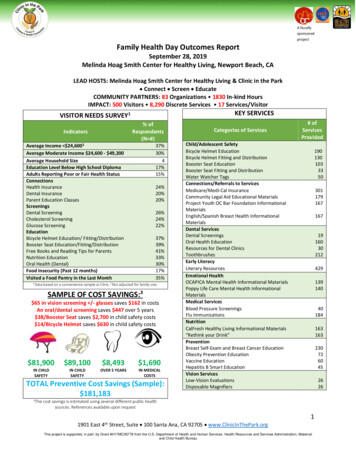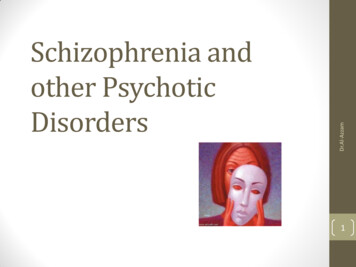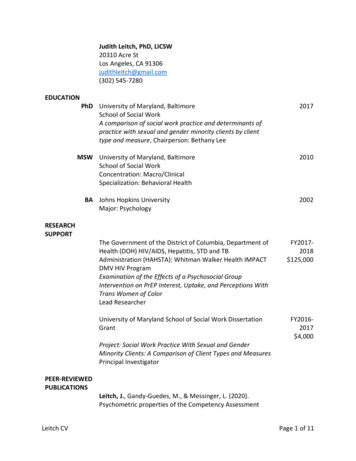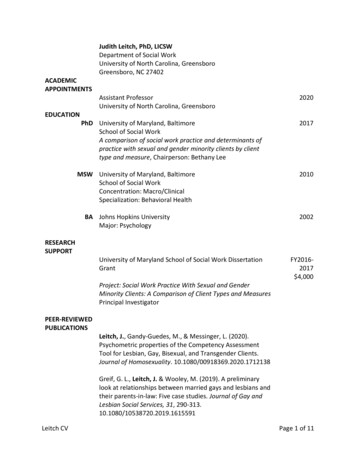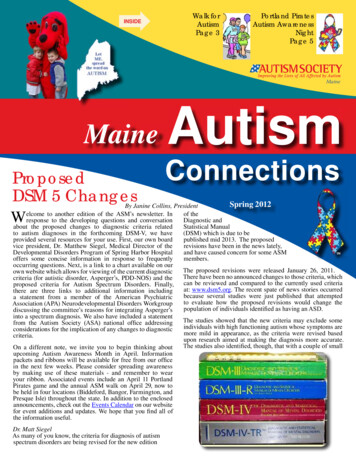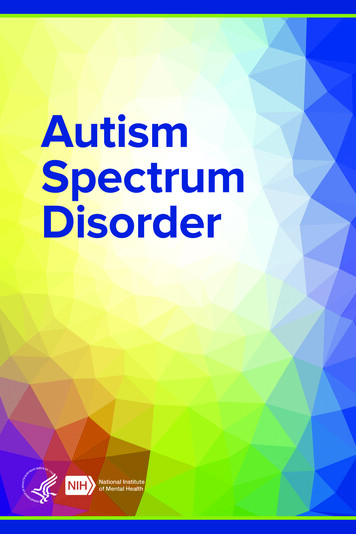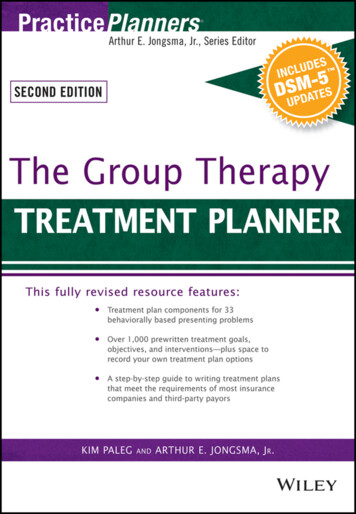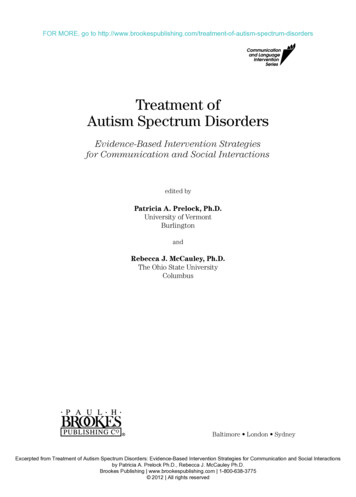
Transcription
FOR MORE, go to sm-spectrum-disordersTreatment ofAutism Spectrum DisordersEvidence-Based Intervention Strategiesfor Communication and Social Interactionsedited byPatricia A. Prelock, Ph.D.University of VermontBurlingtonandRebecca J. McCauley, Ph.D.The Ohio State UniversityColumbusBaltimore London SydneyExcerpted from Treatment of Autism Spectrum Disorders: Evidence-Based Intervention Strategies for Communication and Social Interactionsby Patricia A. Prelock Ph.D., Rebecca J. McCauley Ph.D.Brookes Publishing www.brookespublishing.com 1-800-638-3775 2012 All rights reserved
FOR MORE, go to sm-spectrum-disordersContentsAbout the DVD . . . . . . . . . . . . . . . . . . . . . . . . . . . . . . . . . . . . . . . . . . . . . . . . viiSeries Preface . . . . . . . . . . . . . . . . . . . . . . . . . . . . . . . . . . . . . . . . . . . . . . . . . . xiEditorial Advisory Board . . . . . . . . . . . . . . . . . . . . . . . . . . . . . . . . . . . . . . . xiiAbout the Editors . . . . . . . . . . . . . . . . . . . . . . . . . . . . . . . . . . . . . . . . . . . . . . xiiiAbout the Contributors . . . . . . . . . . . . . . . . . . . . . . . . . . . . . . . . . . . . . . . . . xvForeword Tony Charman . . . . . . . . . . . . . . . . . . . . . . . . . . . . . . . . . xxiiiAcknowledgments . . . . . . . . . . . . . . . . . . . . . . . . . . . . . . . . . . . . . . . . . . . xxix1 Introduction to Treatment of Autism Spectrum Disorders . . . . . 1Patricia A. Prelock and Rebecca J. McCauley2 Reader’s Guide . . . . . . . . . . . . . . . . . . . . . . . . . . . . . . . . . . . . . . . . . . . . 13Rebecca J. McCauley and Patricia A. Prelock3 Augmentative and Alternative CommunicationStrategies: Manual Signs, Picture Communication,and Speech-Generating Devices . . . . . . . . . . . . . . . . . . . . . . . . . . . . 27Jane R. Wegner4 Elementary Behavioral Intervention Strategies: DiscreteTrial Instruction, Differential Reinforcement, and Shaping . . . . 49 Susan M. Wilczynski, Hanna C. Rue, Melissa Hunter,and Lauren Christian5 An Introduction to the Developmental, Individual-Difference,Relationship-Based (DIR) Model and Its Application toChildren with Autism Spectrum Disorder . . . . . . . . . . . . . . . . . . . . 79Sima Gerber6 Functional Communication Training: TreatingChallenging Behavior . . . . . . . . . . . . . . . . . . . . . . . . . . . . . . . . . . . . . . 107V. Mark Durand7 Joint Attention Intervention for Children with Autism . . . . . . . . 139 Connie Kasari, Danai Kasambira Fannin,and Kelly Stickles GoodsvExcerpted from Treatment of Autism Spectrum Disorders: Evidence-Based Intervention Strategies for Communication and Social Interactionsby Patricia A. Prelock Ph.D., Rebecca J. McCauley Ph.D.Brookes Publishing www.brookespublishing.com 1-800-638-3775 2012 All rights reserved
FOR MORE, go to sm-spectrum-disordersviContents8 Implementing Enhanced Milieu Teaching with ChildrenWho Have Autism Spectrum Disorders . . . . . . . . . . . . . . . . . . . . . 163Terry B. Hancock and Ann P. Kaiser9 Early Social Interaction Project . . . . . . . . . . . . . . . . . . . . . . . . . . . . 189 Juliann J. Woods, Amy M. Wetherby, Shubha Kashinath,and Renee Daly Holland10 Peer-Mediated Support Interventions . . . . . . . . . . . . . . . . . . . . . . . 221Erik W. Carter, Lynn G. Sisco, and Yun-Ching Chung11Picture Exchange Communication System (PECS) . . . . . . . . . . . 255Richard L. Simpson and Jennifer B. Ganz12Pivotal Response Treatment . . . . . . . . . . . . . . . . . . . . . . . . . . . . . . . 281Yvonne Bruinsma and Erin K. McNerney13 Social Stories . . . . . . . . . . . . . . . . . . . . . . . . . . . . . . . . . . . . . . . . . . . . 313Tiffany L. Hutchins14 Video Modeling Applications for Persons with Autism . . . . . . . . 345Tom Buggey15 Future Directions . . . . . . . . . . . . . . . . . . . . . . . . . . . . . . . . . . . . . . . . . 371Rebecca J. McCauley and Patricia A. PrelockGlossary . . . . . . . . . . . . . . . . . . . . . . . . . . . . . . . . . . . . . . . . . . . . . . . . . . . . . 389Index . . . . . . . . . . . . . . . . . . . . . . . . . . . . . . . . . . . . . . . . . . . . . . . . . . . . . . . . 399Excerpted from Treatment of Autism Spectrum Disorders: Evidence-Based Intervention Strategies for Communication and Social Interactionsby Patricia A. Prelock Ph.D., Rebecca J. McCauley Ph.D.Brookes Publishing www.brookespublishing.com 1-800-638-3775 2012 All rights reserved
FOR MORE, go to sm-spectrum-disordersEditorial Advisory BoardRonald B. Gillam, Ph.D.Raymond L. and Eloise H.Lillywhite ProfessorCommunicative Disorders andDeaf Education1000 Old Main HillUtah State UniversityLogan, Utah 84322Rebecca J. McCauley, Ph.D.ProfessorDepartment of Speech andHearing ScienceThe Ohio State University134A Pressey1070 Carmack RoadColumbus, Ohio 43210Mary Pat Moeller, Ph.D.Director, Center for ChildhoodDeafnessBoys Town National ResearchHospital555 North 30th StreetOmaha, Nebraska 68131Teresa A. Ukrainetz, Ph.D.Professor, Speech-Language PathologyDivision of Communication DisordersDepartment 3311University of Wyoming1000 E. University AvenueLaramie, Wyoming 82071Susan Ellis Weismer, Ph.D.ProfessorUniversity of Wisconsin–Madison473 Waisman Center1500 Highland AvenueMadison, Wisconsin 53705Paul J. Yoder, Ph.D.Associate Professor in Research TrackThe John F. Kennedy Center forResearch on Human DevelopmentVanderbilt University21st Avenue South and EdgehilleMRL BuildingPeabody Campus Box 328Nashville, Tennessee 37203Editor EmeritusRichard Schiefelbusch, Ph.D.ProfessorSchiefelbusch Institute for Life Span StudiesUniversity of KansasxiiExcerpted from Treatment of Autism Spectrum Disorders: Evidence-Based Intervention Strategies for Communication and Social Interactionsby Patricia A. Prelock Ph.D., Rebecca J. McCauley Ph.D.Brookes Publishing www.brookespublishing.com 1-800-638-3775 2012 All rights reserved
FOR MORE, go to sm-spectrum-disordersAbout the EditorsPatricia A. Prelock, Ph.D., Dean, College of Nursing and Health Sciences, andProfessor, Department of Communication Sciences and Disorders, Universityof Vermont (UVM), Office of the Dean, College of Nursing and Health Sciences,University of Vermont, 105 Rowell, 106 Carrigan Drive, Burlington, VT 05405Patricia A. Prelock’s primary academic appointment is Professor of CommunicationSciences and Disorders; she has a secondary appointment in pediatrics in the Collegeof Medicine. Her primary research interests include collaborative, interdisciplinarypractice and the nature and treatment of autism, including social perspective taking,peer play, emotion regulation, and the neural pathways involved in social discourse.She has served as Associate Editor for Language, Speech, and Hearing Servicesin Schools, was named an American Speech-Language-Hearing AssociationFellow in 2000, and is President-elect of the American Speech-Language-HearingAssociation. Dr. Prelock was the cochair of Vermont’s statewide Autism Task Forcefor four years and is a member of the workgroup for the Autism Training Programthrough the Higher Education Collaborative. Dr. Prelock has more than 120 publications and more than 400 peer-reviewed and invited presentations in the areasof autism, collaboration, language assessment and intervention, and phonology. Dr.Prelock received the 1998 Friends Award through the Vermont Parent InformationCenter, UVM’s Kroepsch–Maurice Excellence in Teaching Award in 2000, and thefirst annual Autism Society of Vermont Excellence in Service Award in 2000. Shewas named a University Scholar in 2003. In 2010, she was awarded the Puppet’sChoice Award for Autism through the Kids on the Block Program. Dr. Prelock earnedher bachelor’s and master’s degrees from Kent State University and her doctoraldegree from the University of Pittsburgh. She is a board-recognized child languagespecialist.Rebecca J. McCauley, Ph.D., Professor, Department of Speech and Hearing Science, Specialist in Child Language, The Ohio State University, 1070 Cermack Road,105 Pressey Hall, Columbus, OH 43210Rebecca J. McCauley joined OSU after 23 years at the Department of CommunicationSciences, the University of Vermont, where she had at various times acted as Director of the Graduate Program and Chair. Her areas of scholarly interest encompass awide range of topics in assessment and treatment of developmental communicationdisorders, with a special focus on childhood apraxia of speech. In addition to having served as an associate editor for the American Journal of Speech LanguagePathology, she has coedited two previous books in the Communication andLanguage Intervention Series: Treatment of Language Disorders in Children(2006) with Marc Fey and Interventions for Speech Sound Disorders in ChildrenxiiiExcerpted from Treatment of Autism Spectrum Disorders: Evidence-Based Intervention Strategies for Communication and Social Interactionsby Patricia A. Prelock Ph.D., Rebecca J. McCauley Ph.D.Brookes Publishing www.brookespublishing.com 1-800-638-3775 2012 All rights reserved
FOR MORE, go to sm-spectrum-disordersxivAbout the Editors(2010) with A. Lynn Williams and Sharynne MacLeod. She has also published threeother books and numerous articles related to developmental communication disorders, including the sole-authored Assessment of Language Disorders in Children(Lawrence Erlbaum Associates, 2001) and the coedited Treatment of Stuttering(Lippincott Williams & Wilkins, 2010). Dr. McCauley earned her bachelor’s degreefrom Louisiana State University and her master’s and Ph.D. degrees from the University of Chicago. She completed postdoctoral studies at the University of Arizonaand the Johns Hopkins University before her first faculty appointment at the University of Vermont. She is a board-recognized specialist in child language and aFellow of the American Speech-Language-Hearing Association.Excerpted from Treatment of Autism Spectrum Disorders: Evidence-Based Intervention Strategies for Communication and Social Interactionsby Patricia A. Prelock Ph.D., Rebecca J. McCauley Ph.D.Brookes Publishing www.brookespublishing.com 1-800-638-3775 2012 All rights reserved
FOR MORE, go to sm-spectrum-disorders1Introduction to Treatment ofAutism Spectrum DisordersPatricia A. Prelock and Rebecca J. McCauleyThis book is intended to introduce readers who are familiar with autismspectrum disorders (ASDs) and their core impairments to a group of interventions focused on communication and social interaction. Because ASDsrepresent a range of deficits in social interaction, verbal and nonverbal communication, and behavior, it is important to consider evidence-based interventions thataddress these core deficits. Therefore, the interventions selected for review in thisbook emphasize both established and emerging methods that are frequently used tosupport the communication and social interaction of individuals typically diagnosedwith autism, Asperger syndrome, and pervasive developmental disorder-not otherwise specified (PDD-NOS).Background on Intervention Strategiesfor Communication and Social InteractionOver the last 15 years, thinking has evolved about which intervention approachesare most appropriate for supporting the social interaction and communication needsof children with ASDs. Although traditional behavioral interventions are wellrepresented in the literature (e.g., Cooper, Heron, & Heward, 2007) and tremendously influential in a variety of settings (Downs, Downs, Johansen, & Fossum,2007; Lafasakis & Sturmey, 2007; Taubman et al., 2001), social-pragmatic developmental interventions are gaining traction, at least in part because they emphasize opportunities for people with ASDs to establish positive social connections andgeneralize their skills in the natural environment. Interest in these approaches hasalso arisen in response to limitations identified in traditional behavioral approachesto ASDs, specifically in terms of generalization of targeted behaviors, particularlythose related to the social use of communication and language (Wetherby & Woods,2006, 2008). Social-pragmatic developmental interventions are the primary focusof this book because they offer a special promise in addressing communication andsocial interaction challenges at the core of ASDs and have the potential to minimizebarriers to the functional application of learning.1Excerpted from Treatment of Autism Spectrum Disorders: Evidence-Based Intervention Strategies for Communication and Social Interactionsby Patricia A. Prelock Ph.D., Rebecca J. McCauley Ph.D.Brookes Publishing www.brookespublishing.com 1-800-638-3775 2012 All rights reserved
FOR MORE, go to sm-spectrum-disorders2Prelock and McCauleyIn the traditional behavioral approach, skills are taught one to one with a predetermined correct response (Karsten & Carr, 2009; Newman, Reinecke, & Ramos,2009; Prelock & Nelson, 2011) and a highly prescribed teaching structure, such asthat characterized by discrete trial instruction (Cooper et al., 2007). In contrast, ina social-pragmatic developmental approach, the interventionist follows the child’slead, fosters initiation and spontaneity, and reinforces contingent responses. Similarstrategies have been implemented for more than 15 years as part of naturalisticcommunication and language interventions for children with a variety of communication and language challenges (Girolametto, Pearce, & Weitzman, 1996; Kaiser,Hancock, & Nietfeld, 2000; Kaiser & Hester, 1994) and have, in the last 10 years,been elaborated upon and modified to address the special challenges presentedby ASDs.Several of the interventions described in this book capitalize on the value ofcombining the best aspects of behavioral and developmental approaches to achievefunctional and relevant social and communicative outcomes for children, adolescents, and adults with ASDs. For example, Prizant and Wetherby (1998) recognizedthe contributions of both traditional behavioral approaches to intervention and olderdevelopmental ones and proposed middle-ground contemporary behavioral interventions to support the communication and social interaction needs of childrenwith ASDs. In particular, they described the value of giving children choices, sharing teaching opportunities between the interventionist and the child, and usingpreferred activities and materials—strategies that characterize Pivotal ResponseTraining (Koegel, Koegel, Harrower, & Carter, 1999; Koegel, Koegel, Shoshan, &McNerney, 1999).As intervention approaches have evolved, so too have comprehensive guidelinesfor best practices. In 2001, the National Research Council (NRC) offered a description of best practices for children with ASDs through the early childhood years. Anumber of intervention guidelines emerged from the NRC’s comprehensive reviewof the literature, including Initiating treatment as soon as possibleEnsuring active engagement during intensive instructionUsing developmentally appropriate, goal-based, systematically planned activitiesImplementing planned teaching opportunities throughout the dayInvolving families and peers in the intervention to facilitate generalized skilllearningMany early intervention programs have used these best practices to design comprehensive educational programs for young children with ASDs.As a follow-up to the NRC’s work (National Research Council, 2001), Iovannone,Dunlap, and Kincaid (2003) proposed six educational practices as appropriate andeffective for school-age children with ASDs. These practices included Providing individualized supports and services that match a student’s profile, asdefined through the individualized education program process Offering systematic, carefully planned, and defined instructional procedures toachieve valid goals, with a process for measuring outcomes Creating a structured learning environmentExcerpted from Treatment of Autism Spectrum Disorders: Evidence-Based Intervention Strategies for Communication and Social Interactionsby Patricia A. Prelock Ph.D., Rebecca J. McCauley Ph.D.Brookes Publishing www.brookespublishing.com 1-800-638-3775 2012 All rights reserved
FOR MORE, go to sm-spectrum-disordersIntroduction to Treatment of Autism Spectrum Disorders3 Adding specialized curriculum content in the areas of social engagement andrecreation and leisure skills Defining a functional approach to problem behaviors Engaging the family in the student’s educational successIn spite of these defined best practices, challenges remained in determining themost effective instructional procedures for children of varying ages, language abilities, and cognitive levels with diagnoses of autism and subthreshold diagnoses, suchas Asperger syndrome and PDD-NOS.In 2009, to address the gaps in the intervention effectiveness literature for thelarge, heterogeneous group of children with ASDs, the National Autism Center (NAC)released the report of its National Standards Project, a comprehensive review of 775intervention studies conducted from 1957 to 2007. Overall, behavioral treatmentswere identified as having the strongest support, and nonbehavioral approaches wereidentified as making a significant contribution but requiring more research. In itsreview, the NAC categorized the level of evidence for several interventions typicallyused in the treatment of individuals with ASDs. The interventions fell into one offour categories: established, emerging, unestablished, and ineffective/harmful.Table 1.1 lists the 12 interventions included in this book according to their level ofevidence at the time of the report’s publication (NAC, 2009).Established treatments were those identified with sufficient evidence leadingto positive outcomes. Emerging treatments were those with one or more studiesyielding positive outcomes but for which study quality and results were inconsistent. Unestablished treatments offered little evidence and required additionalresearch (e.g., academic interventions, auditory integration training, sensory integration package). No treatments were judged to be ineffective or harmful. Theinterventions described in this book fall primarily within the top two categoriesof evidence—established and emerging. Using the National Standards Project as aguide for evidence-based practice with children and youth affected by ASDs, thistimely book emphasizes key established and emerging interventions used to facilitate the communication and social interaction of individuals with ASDs.Purpose of This BookThis book describes and critically analyzes specific treatment approaches used toaddress the communication and social interaction challenges of children, adolescents, and adults with ASDs. Although these challenges are of specific interest tospeech-language pathologists, providers across disciplines have a stake in usingevidence-based intervention to respond to these core areas of impairment for individuals with ASDs. Each approach in this book was selected for inclusion becauseof empirical evidence of its efficacy as established by systematic review or by thepresence of at least two peer-reviewed articles indicating that the approach is awell established and probably efficacious or promising emerging intervention (e.g.,Chambless et al., 1998; Chorpita et al., 2002; NAC, 2009).Traditionally, randomized control trials have been considered the gold standardfor evaluating treatment efficacy. However, such trials are rare in many clinical fields,including treatment for autism. Single-subject experimental designs have providedthe majority of credible evidence in the intervention research in autism (Odom et al.,Excerpted from Treatment of Autism Spectrum Disorders: Evidence-Based Intervention Strategies for Communication and Social Interactionsby Patricia A. Prelock Ph.D., Rebecca J. McCauley Ph.D.Brookes Publishing www.brookespublishing.com 1-800-638-3775 2012 All rights reserved
FOR MORE, go to sm-spectrum-disorders4Prelock and McCauleyTable 1.1. Levels of evidence for interventions included in this book, based on the NationalStandards ProjectLevel of evidenceEstablished (11interventionsidentifieda)Emerging (22interventionsidentified)Level descriptionSufficient evidence thatthe intervention leads topositive outcomesOne or more studies yielding positive outcomes, butstudy quality and resultsare inconsistentChapterin bookIntervention4Discrete trial instruction6Functional communication training7Joint attention intervention8Enhanced milieu teaching9Early Social Interaction Project10Peer mediation12Pivotal Response Treatment13Social Stories 14Video modeling3Augmentative and alternativecommunication5Developmental, IndividualDifference, Relationship-Based (DIR)Model/Floortime11Picture Exchange CommunicationSystem (PECS)Unestablished(five interventions identified)Little evidence available;requiring additionalresearch——Ineffective/harmful (nointerventionsidentified)Interventions that havebeen studied and found tobe ineffective or to havenegative outcomes——From National Autism Center (2009). National Standards Project—findings and conclusions: Addressingthe needs for evidence-based practice guidelines for autism spectrum disorders. Randolph, MA: Author;adapted by permission. aNumber of interventions as identified in National Standards Project report. Only selected interventionsare discussed in this book.2003), yet they are underacknowledged in evaluating treatment efficacy (Barlow,Nock, & Hersen, 2009; Perdices & Tate, 2009). Single-subject designs make important contributions to the research on treatment when they are replicated acrossbehaviors, participants, and contexts; measure change reliably and systematically;have established implementation fidelity; and are socially valid. In fact, results frommany single-subject designs indicate that specific interventions are associated withpositive learning outcomes for individuals with ASDs (Lord et al., 2005). Therefore,the effectiveness of the treatments included in this book has been established primarily through single-subject experimental designs.To facilitate the reader’s understanding of the similarities and differences amongthe interventions in this book—in terms of basic principles, techniques, teachingmethods, treatment targets, and ages for which evidence has been established—a summary table has been provided (see Table 1.2). This table also identifies theevidence rating provided by the NAC (2009) for each of the included i nterventions.Excerpted from Treatment of Autism Spectrum Disorders: Evidence-Based Intervention Strategies for Communication and Social Interactionsby Patricia A. Prelock Ph.D., Rebecca J. McCauley Ph.D.Brookes Publishing www.brookespublishing.com 1-800-638-3775 2012 All rights reserved
ng(Chapter 6)BehavioralDevelopmentalEstablishedDiscrete trial instruction(Chapter 4)SocialpragmaticDevelopmental, EmergingIndividualDifference,RelationshipBased (DIR)Model/Floortime(Chapter 5)EmergingAugmentativeand alternativecommunication(AAC) strategies(Chapter 3)InterventionNationalStandardsProject ratinga Basic principlesFunctional behavioral assessmentSelection of an alternative behaviorFading promptsResponse match, success, efficiency, acceptability, recognizability, andmilieuNatural communities of al developmentIndividual differencesCaregiver–child relationshipsParent- and clinician-implementedAdult-directedIndividualized one-to-one instructionPredetermined correct responsesContingent or differential reinforcementShaping behaviorsOperant conditioningMassed trialsMaintenance trialsMand-model techniquesAssessment of partner and environmentalinfluenceAAC system and target vocabulary selectionMeaningful contextsResponsive partnersNatural environmentFamily- and person-centeredMethodsTable 1.2. Characteristics of each intervention reviewed in the bookReplacement of aggression, self-injury, elopement,and inappropriate sexual behavior with functionalc ommunication forms(continued)3–21years18monthsto 9years3–21yearsCommunication, social, and adaptive skillsUse of verbal operants (e.g., mands, tacts, echoics,intraverbals)Shared attention and regulationEngagement and relatingTwo-way intentional communicationComplex problem-solvingCreative representations and elaborationRepresentational and emotional thinkingToddlerthroughadultAgesEnhancement of existing communication skillsExpanded languageSubstitute for inadequate speechStructure to support language developmentTargetsFOR MORE, go to sm-spectrum-disorders5Excerpted from Treatment of Autism Spectrum Disorders: Evidence-Based Intervention Strategies for Communication and Social Interactionsby Patricia A. Prelock Ph.D., Rebecca J. McCauley Ph.D.Brookes Publishing www.brookespublishing.com 1-800-638-3775 2012 All rights reserved
ngJoint attentionintervention(Chapter 7)Enhanced milieu teaching(Chapter 8)Early Social Interaction Project(Chapter 9)Peer mediation(Chapter 10)PictureExchange CommunicationSystem (PECS)(Chapter havioral anddevelopmentalBehavioral anddevelopmentalNationalStandardsProject ratinga Basic principlesTable 1.2. (continued)Systematic teachingTime delayDirect, natural reinforcementShapingModelingPromptingVisually basedPeer interaction trainingPeer network strategiesRegular opportunities to interact withinand outside instructional settingsAdult coaching, guidance, and supportInclusive environmentCommunities of reinforcementInstructional arrangements (e.g., cooperative groups, peer supportarrangements)Family-basedChild directedEnvironmental arrangementResponsive interactionsPreferred activities and materialsRoutine-basedNatural environmentEnvironmental arrangementResponsive interactionLanguage modelingMilieu teachingParent- and clinician-implementedDirected instructionIndividualizedIntensiveMilieu teachingParent- and Initiating and maintaining conversationExchanging complimentsTaking turnsHelping behaviorsSharing materialsCollaborating on assignmentsMaking introductionsConversing about shared interestsSpontaneous initiation of requestsRequests for reinforcing items/activities, help, breakRejecting offers for undesired items or activitiesAffirming offers for desired items or activitiesFollowing a direction to waitResponding to directionsFollowing transitional cues and visual schedules18monthsto 3years3–9years3–5yearsAgesSocial communication from preverbal to multiwordstageGesture useInitiation of and response to joint attentionWord knowledgeReciprocityProductive, spontaneous, and meaningful use of newlanguage formsInitiations and responsesResponse to and spontaneous initiation of joint attentionTargetsFOR MORE, go to sm-spectrum-disorders6Excerpted from Treatment of Autism Spectrum Disorders: Evidence-Based Intervention Strategies for Communication and Social Interactionsby Patricia A. Prelock Ph.D., Rebecca J. McCauley Ph.D.Brookes Publishing www.brookespublishing.com 1-800-638-3775 2012 All rights reserved
EstablishedEstablishedSocial Stories (Chapter 13)Video modeling(Chapter 14)Behavioral anddevelopmentalSocialpragmaticBehavioral anddevelopmentalVisually basedViewing positive video modelsAdult and peer modelingPoint-of-view modelingSelf-modeling, including feed forwardand positive self-reviewVisually basedSituation-specificIndividualized instructional strategy (e.g.,determine topic, gather information,develop the story, consider additionalsupports, critical review, introducestory, generalization training, maintenance, fading)Play-basedFamily-basedNatural environmentRoutine-basedChild choiceTaking turnsShared control of teaching opportunitiesDirect and natural reinforcementReinforcing communication attemptsPreferred activities and materialsInterspersing maintenance tasks withinteaching sessionsTeach new skills or improve existing skills across developmental domains (e.g., self-help skills: dressing,feeding, washing)Cognitive skills (e.g., play, perspective-taking, attention)Social skills (e.g., conversation, prosody, taking turns)Language skills (e.g., question asking and answering,greeting, comprehending stories)Replace or extinguish maladaptive behaviorReduction of disruptive behaviors (e.g., tantrums, aggression, self-injurious acts)Establish routinesIntroduce changes in routinesUnderstanding of a new or unfamiliar eventSocial skills (e.g., getting a peer’s attention, makingchoices, playing independently, peer engagement,participation)Communication (e.g., reduction of echolalia, interrupting, loud talking)First wordsBasic social skillsSophisticated language and social skillsPivotal behaviors (e.g., motivation, responsivity to multiple cues, self-management, self-initiations)3–18years6–14years3–9yearsa From National Autism Center (2009). National Standards Project—findings and conclusions: Addressing the needs for evidence-based practice guidelines for autism spectrumdisorders. Randolph, MA: Author; adapted by permission.EstablishedPivotalResponse Treatment(Chapter 12)FOR MORE, go to sm-spectrum-disorders7Excerpted from Treatment of Autism Spectrum Di
determined correct response (Karsten & Carr, 2009; Newman, Reinecke, & Ramos, 2009; Prelock & Nelson, 2011) and a highly prescribed teaching structure, such as that characterized by discrete trial instruction (Cooper et al., 2007). In contrast, in a social-pragmatic develo


